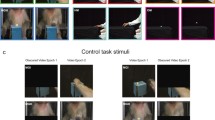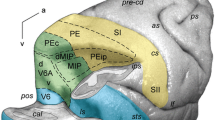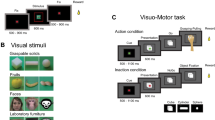Summary
1. Single neuron activity was recorded from the prefrontal cortex of two macaque monkeys during the performance of a task involving spatial sequencing. The monkeys faced a panel displaying a central fixation point and three fixed targets (two lateral and one above the point of fixation). In the first phase of each trial, the three targets were turned on in random order: in the second phase, the animal had to press each target, still lighted, in the order of their illumination. Thus, successful performance of the task depended strongly on temporal memory. The animals were fitted with DC-EOG electrodes. 2. Three hundred and two task-related neurons were recorded in the superior arcuate area and caudal part of sulcus principalis. Among the cells whose pattern of activity appeared to be related to the sequencing task, five classes were distinguished: Visual tonic (VT), fixation, context, saccade related and visual phasic cells. In addition, a small number of cells appeared to be related to other aspects of the behavior, but not to the sequencing task. Our present analysis concentrates on two groups of sequencing task-related cells (VT and context cells). 3. The VT cells (35/302-11.5%) were recorded exclusively from the superior arcuate area. All VT cells increased their firing rate (sustained activation) during fixation of the central fixation point (FP) following onset of one of the three targets used, specific for a given cell (directional or spatial selectivity). In one group of VT cells, a shift in the eye position towards the specific peripheral target resulted in the return of the cells' firing rate to the pre-trial level. In the other group of VT cells, reset of the firing rate to pre-trial level was not related to the onset of fixation of the peripheral target. Sustained activation of the VT cells depended also on the sequential order of illumination of the specific target (temporal selectivity). In twenty-four cells (68.5% of VT cells) sustained activation was observed when the target came first in the sequence. Onset of the target in the second or third rank elicited either no response or only a short lasting phasic activation. In the remaining eleven cells (31.5% of VT cells), sustained activation was only observed when the target came second in a given sequence. The firing of the VT cells was correlated with the animals' performance of the task. On trials where the animals selected successive targets in an incorrect order, the temporal pattern of activation of VT cells was different from that in the correctly performed trials. Thus, the correct temporal encoding of a target appeared to be a prerequisite for the correct performance of a sequence. 4. The context cells (36.5%-16/302) were activated when the animal fixated a particular target during execution of the sequence and, like VT cells, were encountered exclusively in the penetrations through the superior arcuate area. Activation also depended on the state (illuminated vs extinguished or hit vs non-hit) of the non-fixated targets and/or on their time-relationships with respect to the fixated target hence context cells. 5. Properties of VT and context cells revealed in the present experiment are consistent with the idea that the superior arcuate area is involved in temporally and spatially extended structures of behavior. If so, the arcuate area would constitute a specialized part of prefrontal cortex implicated in construction of oculomotor plans.
Similar content being viewed by others
References
Barbas H, Mesulam MM (1981) Organization of afferent input to subdivisions of area 8 in the rhesus monkey. J Comp Neurol 200:407–431
Barbas H, Mesulam MM (1985) Cortical afferent input to the principalis region of the rhesus monkey. Neuroscience 15:619–637
Brody BA, Pribram KH (1978) The role of frontal and parietal cortex in cognitive processing: test of spatial and sequence functions. Brain 101:607–633
Bruce CJ, Goldberg ME (1985) Primate FEF. I. Single neurons discharging before saccades. J Neurophysiol 53:603–635
Bruce CJ, Goldberg ME, Bushnell MC, Stanton GB (1985) Primate FEF. II. Physiological and anatomical correlates of electrically evoked eye movements. J Neurophysiol 53:714–734
Collin NG, Cowey A, Latto R, Marzi C (1982) The role of frontal eye field and superior colliculi in visual-search and non visual-search in rhesus monkey. Behav Brain Res 4:177–193
Crowne DP, Yeo CH, Russell IS (1981) The effect of unilateral frontal eye field lesions in the monkey: visual motor guidance and avoidance. Behav Brain Res 2:165–185
De Renzi E, Faglioni P, Lodesani M, Vecchi A (1983) Performance of left-brain damage patients on imitation of single movements and motor sequences: frontal and parietal injured patients compared. Cortex 19:333–343
Funahashi S, Bruce CJ, Goldman-Rakic PS (1989) Mnemonic coding of visual space in the monkey's dorsolateral prefrontal cortex. J Neurophysiol 61:331–349
Fuster JM (1985) Temporal organization of behavior. Hum Neurobiol 4:57–60
Goldman-Rakic PS (1987) Circuitry of primate prefrontal cortex and regulation of behavior by representational memory. In: Handbook of physiology. Chap. V. The nervous system 9:373–417
Joseph JP, Barone P (1987) Prefrontal unit activity during a delayed oculomotor task in the monkey. Exp Brain Res 67:460–468
Kimura D (1982) Left hemisphere control of oral and brachialmovements and their relation to communication. Philos Trans R Soc B298:135–149
Kolb B, Milner B (1981) Performance of complex arm and facial movement after focal brain lesions. Neuropsychologia 19:491–503
Luria AR (1966) Higher cortical functions in man. Tavistock, London
Mesulam MM (1981) A cortical network for directed attention and unilateral neglect. Ann Neurol 10:309–325
Milner B, Petrides M, Smitt ML (1985) Frontal lobes and the temporal organization of memory. Hum Neurobiol 4:137–142
Passingham RE (1985a) Memory of monkeys (Macaca mulatta) with lesions in prefrontal cortex. Behav Neurosci 99:3–21
Passingham RE (1985b) Prefrontal cortex and sequencing of movement in monkeys (Macaca mulatta). Neuropsychologia 23:453–462
Petrides M, Milner B (1982) Deficit on subject-ordered task after frontal and temporal lobe lesion in man. Neuropsychologia 20:249–262
Petrides M (1985) Deficit in non-spatial conditionnal associative learning after periarcuate lesions in the monkey. Behav Brain Res 16:95–101
Pinto-Hamuy T, Link P (1965) Effects of frontal lesions on performance: sequential tasks by monkeys. Exp Neurol 12:96–107
Schlag J, Schlag-Rey M (1987) Evidence for a supplementary eye field. J Neurophysiol 57:179–200
Stuss DT, Benson DF (1986) The frontal lobe. Raven Press, New York
Stuss DT, Benson DF (1987) The frontal lobe and control of cognition and memory. In: The frontal lobe revisited. Pergamon, pp 141–158
Suzuki H, Azuma H (1977) Prefrontal neuronal activity during gazing at a ligh spot in monkey. Brain Res 126:497–508
Suzuki H (1985) Distribution and organization of visual and auditory neurons in the monkey prefrontal cortex. Vision Res 25:465–469
Author information
Authors and Affiliations
Rights and permissions
About this article
Cite this article
Barone, P., Joseph, J.P. Prefrontal cortex and spatial sequencing in macaque monkey. Exp Brain Res 78, 447–464 (1989). https://doi.org/10.1007/BF00230234
Received:
Accepted:
Issue Date:
DOI: https://doi.org/10.1007/BF00230234




